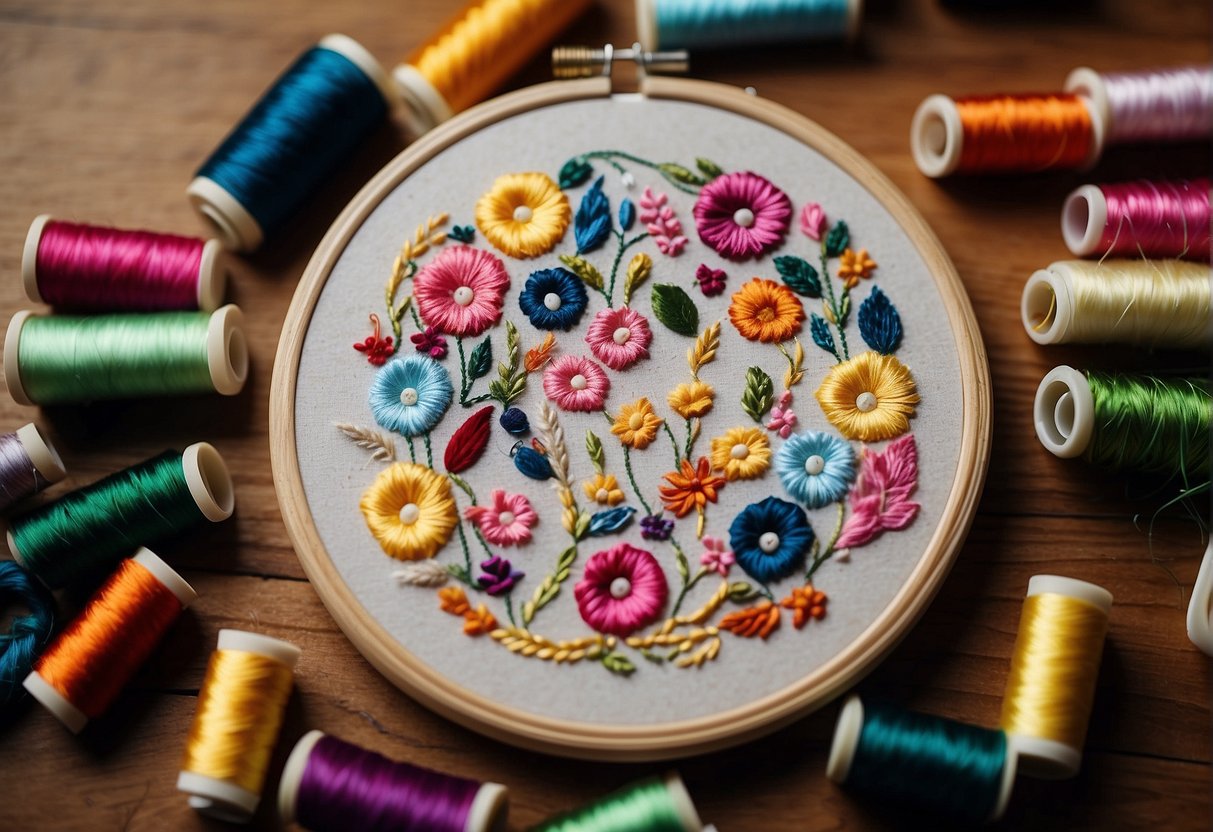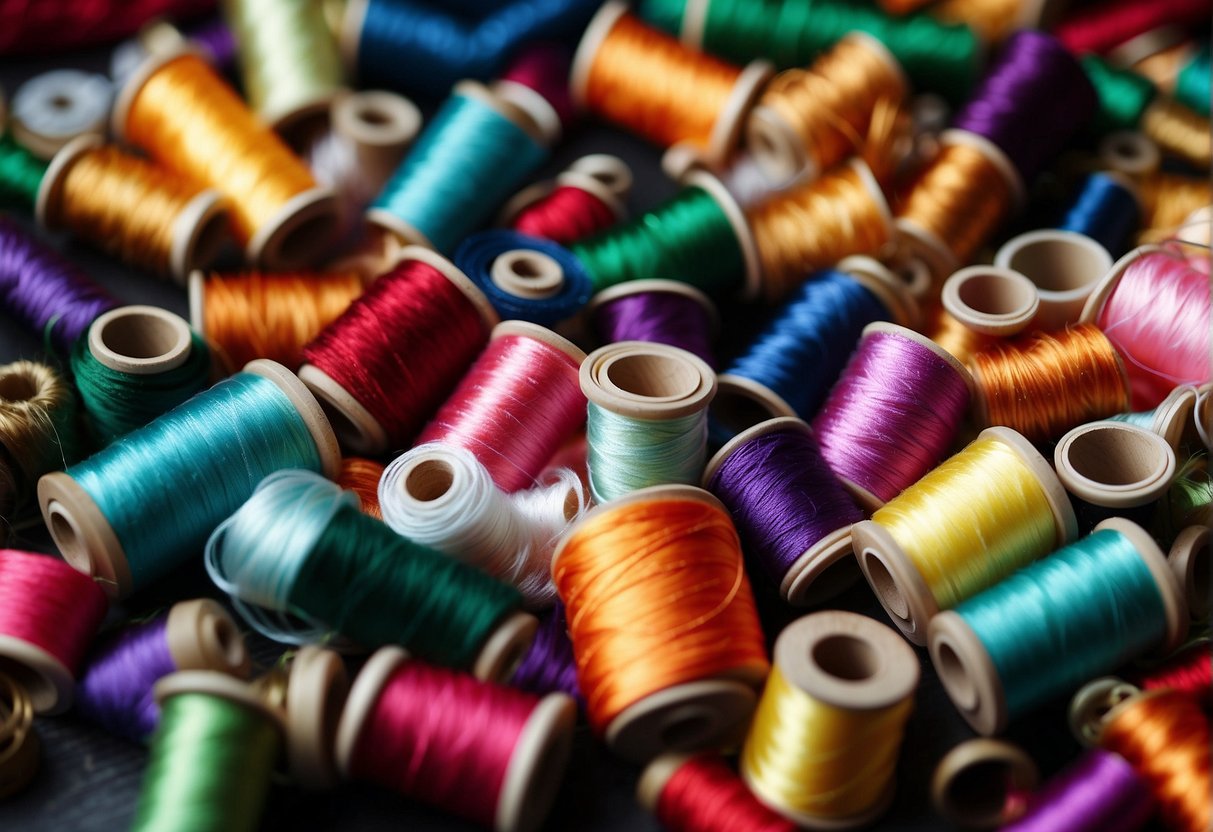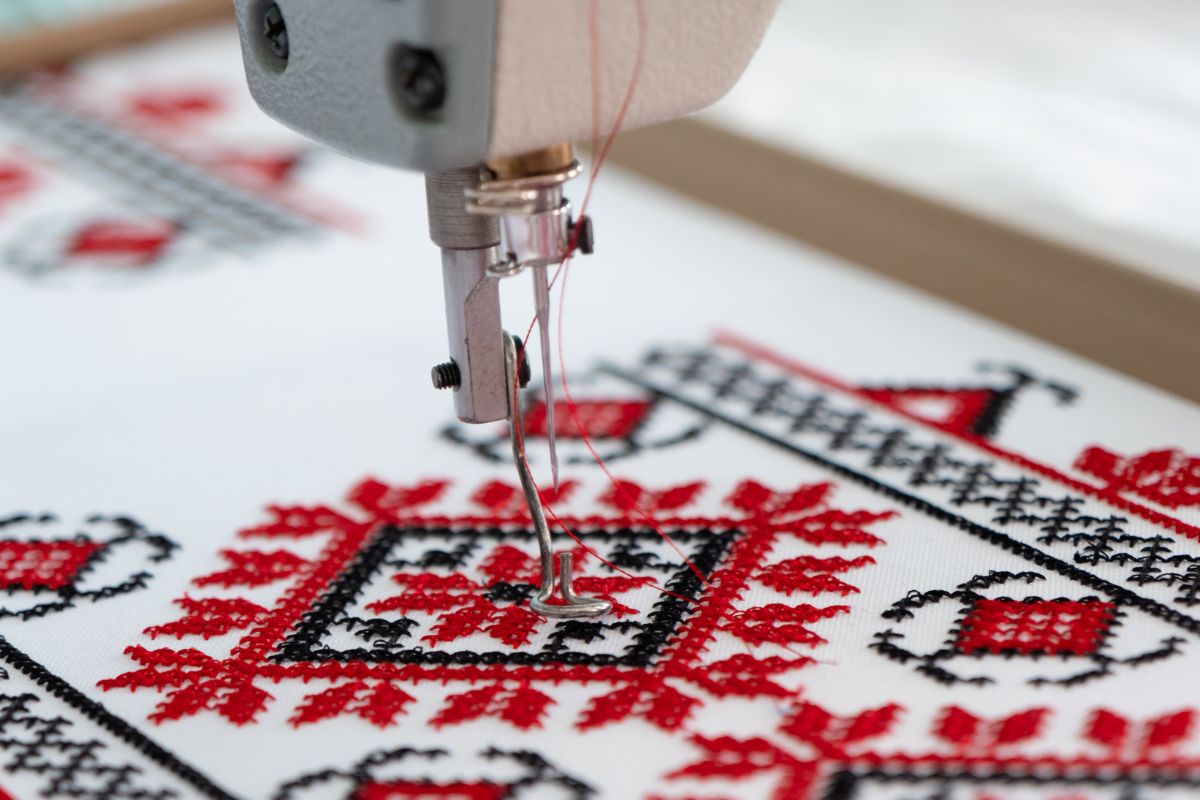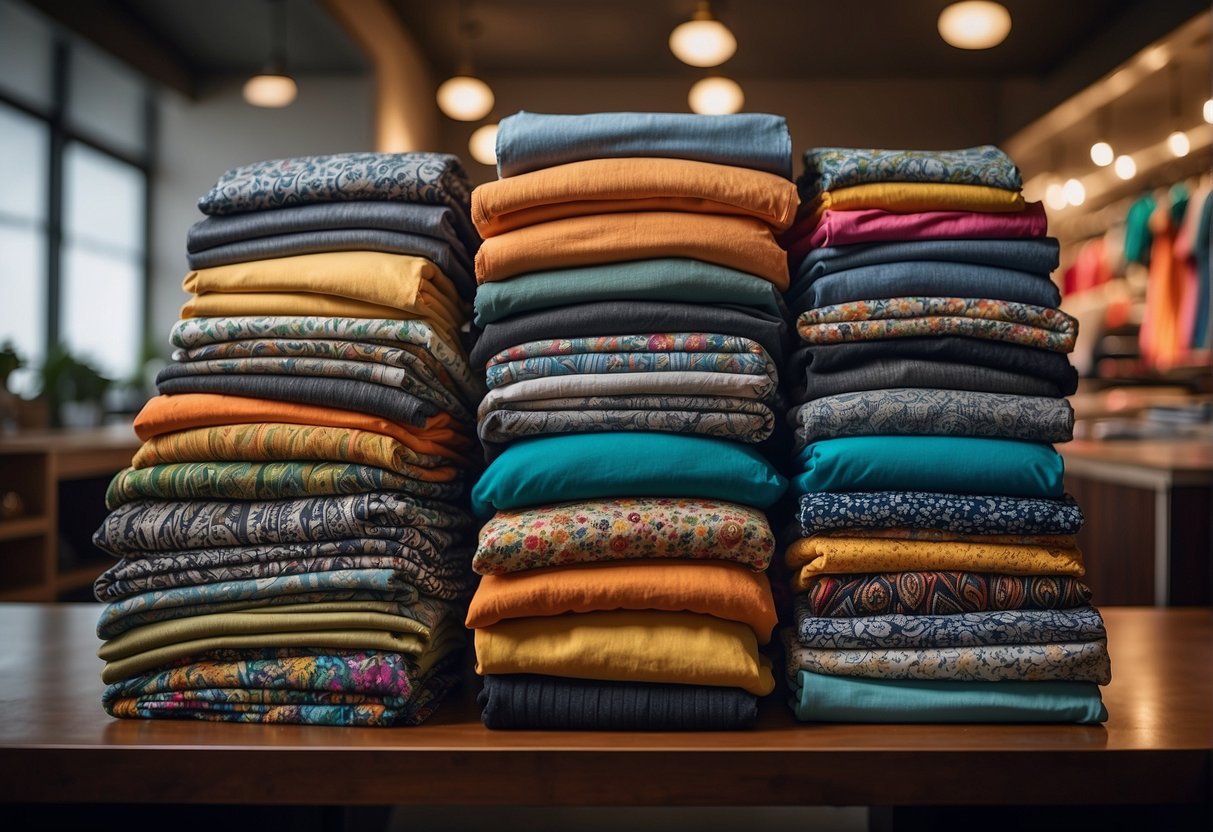Embroidery offers a unique and versatile way for you to express your creativity. This age-old craft has transformed from traditional methods to incorporate modern digital designs, allowing both beginners and experienced embroiderers to turn their creative ideas into high-quality works of art. Whether you are looking to adorn your garments with intricate patterns or create standalone pieces, the possibilities in embroidery are almost endless.
As a beginner, your journey into the world of embroidery starts with learning basic stitches. Techniques such as the running stitch, back stitch, and satin stitch form the foundation upon which you can build more complex patterns. The key is to practice these fundamental stitches until they feel natural, thereby setting a solid base that ensures your future projects have the precise and beautiful finish you desire.
Moving beyond the basics, you have the opportunity to explore a plethora of stitches and techniques, each bringing a different texture and aesthetic to your work. Learning to select and apply the right stitch for your design is a skill that comes with time, but as you grow more confident, you can transform your embroidery ideas into stunning pieces that reflect your personal style. Exploring various embroidery techniques and experimenting with color and fabric choices will further enhance the uniqueness of your creations.
Embroidery Basics
Embroidery offers a blend of creativity and technique, with an array of stitches to learn and tools to master. This section introduces you to the world of embroidery, outlining the essentials you need to begin your journey.
Understanding Embroidery
Embroidery is the art of decorating fabric using a needle and thread. Your creativity, paired with basic stitches and patterns, transforms simple materials into intricate designs. Embroidery can be done by hand or with a machine, but mastering hand embroidery provides a solid foundation for all your future work.
Essential Embroidery Tools
To start embroidering, you need the right tools. Here’s a list of the essentials:
- Needles: Embroidery needles, with their sharp points and larger eyes, are specially designed for threading embroidery floss.
- Hoop: An embroidery hoop keeps your fabric taut and easy to work on. Ensure that the hoop fits your project size.
- Fabric: Choose even-weave fabrics like linen or cotton; their consistent structure supports even stitching.
- Thread: Embroidery floss is available in a spectrum of colors. Start with a basic palette and expand as needed.
Basic Stitches Explained
Understanding and practicing basic stitches is crucial. Here are a few to get you started:
- Running Stitch: A simple stitch that weaves in and out of the fabric. It’s often used for outlining.
| Steps | Description |
| 1 | Push the needle up through the fabric. |
| 2 | Go forward a stitch length and push the needle down through the fabric. |
| 3 | Repeat while keeping the stitches and spaces uniform. |
Back Stitch: For lines with no gaps, back stitch creates a continuous line by stitching backward.
Technique:
1. Pull the needle up at A, go down at B.
2. From underneath, come up at C, a stitch length ahead.
3. Go back into B; this is your “back” stitch.
4. Continue to B, C, D, and so on.
Split Stitch: The split stitch creates a braided line and is a foundational stitch for intricate work.
- Start with a single stitch forward.
- Bring the needle up through the center of the stitch, splitting the thread.
- Continue forward, splitting each previous stitch.
Learn these stitches to create a canvas of textures and patterns. They are the building blocks for all your embroidery projects, so take the time to practice them well.
Project Ideas for Beginners

Embroidery offers endless creativity, especially for beginners eager to explore the craft. Starting with simple, yet satisfying projects can help you build confidence and skills.
Simple Home Accessories
Cushions: Start with a basic square cushion cover. Choose a simple pattern such as a floral design or a geometric shape to practice satin stitch or backstitch. It’s a practical way to add a handmade touch to your living space.
Table Linens: Enhance your dining experience with hand embroidered napkins or placemats. Even simple running stitches along the edges can turn plain linen into elegant tableware. Opt for cotton or linen materials for easier handling.
Personalized Clothing Projects
Monogrammed T-Shirts: Personalize a plain t-shirt with a monogram of your initial using a straightforward back or split stitch. This entry-level project will introduce you to the basics of transferring patterns onto fabric.
Embroidered Patches: Create DIY patches for jeans or jackets. You can cut out simple shapes from spare fabric and practice various stitches to fill them in, like French knots or chain stitches.
Creative Gift Items
Cards: Use embroidery to elevate handmade cards — just puncture the card with a design and stitch through it. It’s an excellent way to practice your skill and make a personalized keepsake.
Kids’ Tote Bags: A tote bag with an embroidered motif is both fun and useful. Select bold, easy-to-follow patterns that appeal to kids and work on a durable canvas material that can withstand daily use.
Remember, select projects that you feel connected to and take your time with each stitch. Enjoy the process as much as the result!
Materials and Fabrics

Selecting high-quality materials and fabrics is vital for ensuring your embroidery projects are both beautiful and durable. Your choices will affect the final texture, appearance, and usability of your embroidered items, whether they are sweaters, jeans, hoodies, towels, or napkins.
Choosing the Right Fabric
When deciding on the fabric for your embroidery, consider the weight and weave. A tight weave, such as that found in cotton poplin or linen, provides a stable foundation for embroidery patterns. For a more delicate look, lightweight fabrics like silk or organza can be used, but they require a careful touch. For items like sweaters and hoodies, choose stretchy fabrics designed to handle movement without distorting your embroidery.
Threads and Yarns
The selection of threads and yarns will greatly influence the texture and color vibrancy of your embroidery. Cotton threads are versatile and suitable for most fabrics, making them ideal for towels and napkins. If you are working on a project with heavier materials like jeans, consider using a stronger polyester or rayon thread that can handle the fabric’s heft without breaking.
Stabilizers and Interfacing
Using stabilizers and interfacing helps to maintain fabric tension and supports the material during the embroidery process. Cut-away stabilizers work well for clothing items like hoodies and sweaters that endure frequent use and laundering. Tear-away stabilizers are a good match for firm fabrics used in projects where the stabilizer needs to be completely removed, like on napkins.
Machine Embroidery

Embarking on machine embroidery requires not only creativity but also an understanding of how to best utilize your machine and materials for outstanding results. From selecting the right patterns for your jackets and sweatshirts to properly maintaining your equipment, acquiring these skills is essential to bring your embroidery projects to life.
Getting Started with Machine Embroidery
When you first set up your embroidery machine, start with simple projects like customizing aprons or polo shirts. Ensure you select the correct type of stabilizer and thread for the material you are working with. Familiarize yourself with operating your machine by practicing on test fabrics before moving on to accessories or caps to boost your confidence.
Machine Embroidery Designs
Exploring a variety of embroidery patterns will expand your creative possibilities. From classic floral designs on totes to contemporary geometric patterns on ponchos, there is a wide range to choose from. Remember that designs need to be compatible with your machine’s format, and selecting the appropriate size and color palette is crucial for the end result.
Embroidery Patterns:
- Floral: Suited for aprons, totes
- Geometric: Great for ponchos, jackets
- Monograms: Personalize polo shirts, caps
Maintaining Your Embroidery Machine
Regular maintenance of your embroidery machine is vital to ensure its longevity and performance. Clean the bobbin area after each project, oil the machine as per the manufacturer’s guide, and replace needles frequently to ensure smooth operation. This will help you to consistently produce high-quality embroidery on sweatshirts, jackets, and other garments.
Keep these tips in mind as you navigate through the realms of machine embroidery, and watch your designs flourish on a multitude of textiles and accessories.
Hand Embroidery Techniques

Embroidery is an art form where you use various stitches and techniques to create patterns and designs with needle and thread. Understanding the different methods is crucial to choosing the right one for your project and improving your skills.
Freestyle Embroidery
In freestyle embroidery, you can let your creativity flow, using a hoop to stabilize the fabric as you stitch any design of your choice. This type of embroidery does not rely on a predetermined pattern or counting threads, allowing you to express unique ideas with your needlework. For instance, you may use satin stitches to fill areas with silky texture or backstitches for defined lines.
Counted Thread Techniques
Counted thread embroidery relies on the fabric’s weave to create symmetrical stitches. Precise and even, these techniques often yield geometric patterns. Cross-stitch, a popular form of counted thread work, requires counting the threads of the fabric to ensure uniformity. This technique provides a structured approach to hand-embroidered patterns, ideal for beginners who are learning hand positioning and thread tension.
Decorative Stitches
Decorative stitches add texture and embellishment to your embroidery. Some common examples include the French knot, which produces small, raised dots perfect for eyes in a character’s face or texture in a floral pattern. The lazy daisy stitch creates delightful looped petals, often found in floral patterns. Incorporating a variety of decorative stitches can bring your hand embroidery to life, adding depth and interest.
Embroidery on Various Clothing
Embroidery elevates ordinary garments into personalized articles of clothing, whether you’re aiming to add a touch of elegance to your casual wear or make a statement with baby and kids’ clothing.
Casual Wear Embellishments
- T-shirts & Tank Tops: Add a unique flair to your t-shirts with simple yet stylish designs such as monograms or small motifs. For tank tops, consider border embroidery along the neckline or hem for an understated chic look.
- Sweaters & Sweatshirts: Transform your sweaters by embroidering intricate patterns on the sleeves or chest area. With sweatshirts, large back pieces or sleeve decorations are current trends that stand out.
- Aprons & Bibs: Customize your aprons with themed embroidery, perfect for gifting to those who love cooking or crafting. For babies’ bibs, playful characters or sweet sayings make mealtime messes a little more delightful.
- Pants & Jeans: Embroider small details on the pockets of pants or run a vine pattern down the leg of jeans to turn them into a one-of-a-kind pair.
Formal and Specialty Items
- Night Gowns & Pajamas: A subtle, personalized touch on night gowns or pajamas, like a monogram or a small emblem, adds a sense of sophistication and luxury to sleepwear.
- Ties & Jackets: For ties, discreetly place a small emblem or initials at the bottom for a personalized touch. Embellish jackets with sophisticated badge-like designs on the breast pocket or custom back pieces for a stylish statement.
Baby and Kids Clothing
- Onesies & Beanies: Little onesies can be enlivened with colorful characters or initials, while beanies can bear tiny symbols or names wrapped around the brim for an adorable look.
- Socks & Pajamas: Customize children’s pajamas with their favorite animals or bedtime themes. For socks, a small icon or the child’s name near the top can add a fun twist to a typically mundane item.
- Jackets & Sweatshirts: Making youngsters’ jackets and sweatshirts unique is easy with bold patterns or their favorite cartoon figures stamped across the back or embroidered onto the front.
Beyond Clothing: Embroidery in Home Decor

Embroidery can transform your living space by adding a personal touch to a variety of home textiles and decorations. From practical items like towels and pillowcases to decorative tablecloths and seasonal adornments, embroidery infuses elegance and character into your home décor.
Functional Home Textiles
Towels: Customize your bathroom with embroidered towels that not only serve their purpose but also add a decorative element. Choose designs that complement the theme of your bathroom, like nautical motifs for a seaside-inspired room.
Blankets and Pillowcases: Create a cozy atmosphere in your bedroom by decorating blankets and pillowcases with intricate embroidery. Floral patterns or monograms can give a classic, bespoke feel.
Bags and Toilet Paper Holders: Elevate the everyday items in your home to something special. An embroidered tote bag for bread or a delicately designed holder can add unexpected beauty to functional objects.
Decorative Accents
Cushions and Coasters: Use bold stitches on pillowcases to add a pop of color to your living room. Embroidered coasters protect surfaces and can match the seasonal decor or the room’s color scheme.
Curtains and Shower Curtains: Give your windows and bathroom a lift with embroidered curtains or shower curtains. The subtle detailing can tie together the overall aesthetic of the room.
Table Runners and Tablecloths: Set an impressive dining experience with elegantly embroidered table runners and tablecloths. Whether it’s a simple family meal or a special occasion, these pieces can make every dining moment feel significant.
Seasonal Decorations
Christmas Ornaments and Garland: Hand-stitched Christmas ornaments give your tree a unique touch, while embroidered garland can frame doorways or mantels beautifully, filling your home with holiday cheer.
Valentine’s Day Decor: Celebrate love with embroidered items like heart-shaped coasters or a Valentine’s-themed tablecloth. These creations can become lovely traditions you’ll look forward to displaying each year.
Remember, adding embroidery to your home decor offers a timeless appeal and a sense of craftsmanship and thoughtfulness to your living spaces.
Accessorizing with Embroidery

Embroidery can transform your personal style and everyday items into unique expressions of creativity. By adding embroidered accents, you elevate both form and function in accessories.
Personal Accessories
Glasses Cases: You can personalize your glasses cases with fine, detailed embroidery, ensuring both protection and style. Whether subtle or bold, an embroidered glasses case becomes more than just storage—it’s a fashion statement.
Belts and Hats: Embroidered belts add a touch of individuality to your attire, especially when paired with jeans. Consider a pattern that complements your outfit’s palette. Meanwhile, hats, including caps, bucket hats, and visors, adorned with unique needlework, showcase your personal brand from head to toe.
Footwear and Outerwear
Shoes: Embroidery can breathe new life into footwear. Quick tips for shoes:
- Choose complementing thread colors
- Opt for designs that match the shoe’s contours
Jackets: An embroidered patch on the back of a denim jacket can turn an ordinary piece into a centerpiece of conversation. Seek inspiration from your interests, such as wildlife or geometric patterns, to make a truly signature piece.
Travel and Lifestyle Items
Bags: Backpacks, clutches, and duffel bags are not just utilitarian; they’re an opportunity for self-expression. Embroidery on these items can range from subtle monograms to large, intricate landscapes. Make sure your travel pieces stand out on your next adventure.
Coolers and Ribbons: Even practical items like coolers can benefit from embroidery, making them easy to identify at gatherings. Decorative ribbons, either as hair accessories or bag embellishments, can tie your entire look together with a thread of continuity.
Special Techniques and Applications
Embroidery is not just about traditional stitches on fabric; it extends to the realm of texture, luminosity, and unconventional canvases. By integrating special techniques and unique materials, you can elevate your embroidery projects.
3D Embroidery
When you add dimension to your work with 3D embroidery, your crafts gain a dynamic edge. You can achieve a three-dimensional appearance by layering dense stitches or using padding underneath. For a nature-inspired design, consider creating a plump flower or a lifelike bee, which seems to almost buzz away from an apron or art piece.
Metallic and Glow Threads
Brighten up your work with metallic and glow threads that catch the light or illuminate in the dark. These special threads can transform a simple design into one that stands out, especially on items that move and fold, like shoes. Metallic threads can add shimmer to a starry night pattern, while glow threads could make a Halloween-themed project come alive after dark.
Innovative Embroidery Surfaces
Explore beyond the boundaries of traditional textiles by embroidering on experimental materials. Leather, plastic, and even metal can serve as novel bases for your stitches and patterns. This avant-garde approach can open up a range of possibilities, such as embellishing a durable backpack or adding artisanal flair to sturdy shoes.
Remember to select the right needle and threads for your chosen material to ensure the best results and truly showcase the versatility of your embroidery skills.
Troubleshooting Common Embroidery Issues
When you encounter problems in your embroidery projects, knowing how to troubleshoot common issues can save you time and frustration. Below, you’ll find specific solutions to challenges related to fabric, threads, needles, and machine malfunctions.
Fabric-related Challenges
Fabric Puckering: Ensure your fabric is properly hooped, with adequate tension to avoid puckering. Sometimes stabilizers are needed; use a cut-away or tear-away stabilizer for the best results.
Wrong Fabric Choice: Each embroidery project may require a different type of fabric. Check that the fabric you’re using is suited for your pattern’s recommended fabric type to avoid issues with stitches not laying flat.
Thread and Needle Problems
Thread Breaking: If your thread constantly breaks, check your needle. A blunt, bent, or incorrect size needle can cause this issue. Replace it with the correct size; sizes 10 or a 12 are commonly used for embroidery.
Tension Issues: Your thread should flow smoothly through the fabric. If not, adjust your machine’s tension settings. Good tension is when your stitches form smoothly without loops and without pulling too tightly on the fabric.
Machine Embroidery Malfunctions
Machine Errors: Keep your machine’s software up to date and refer to the manufacturer’s manual for specific error codes. Regular maintenance is essential to prevent unexpected machine errors.
Hoop Alignment: Make sure your hoop is securely attached and properly aligned with your machine. Misalignment can lead to uneven stitching and design distortion.
By methodically checking each element — fabric, needle, thread, and your machine — you can effectively address and fix the common issues that arise during your embroidery projects.
Frequently Asked Questions
Embroidery can transform ordinary items into unique, personalized works of art. This section answers some common queries to help you begin your embroidery journey with confidence.
What are some beginner-friendly projects for someone new to embroidery?
As a novice, consider starting with simple projects such as embroidered handkerchiefs, bookmarks, or monogrammed towels. These projects offer a manageable canvas for you to practice basic stitches and techniques.
Which embroidery stitches should I start with for simple designs?
For those new to embroidery, foundational stitches like the running stitch, backstitch, and straight stitch are your bread and butter. They create clean lines and are easy to learn, forming the basis for more complex designs later on.
How can I use embroidery to enhance my clothing and accessories?
Embroidery can revitalize your wardrobe; add floral motifs to the collars or cuffs of a shirt, or personalize tote bags and hats with your initials or small designs. It’s an ideal method to add a touch of personal flair.
Can you suggest some unique embroidery projects for gifting?
Embroidered gifts show thought and creativity. Consider customizing kitchen linen, creating a wall hanging, or even a photo album cover with embroidered detailing. These projects are not only charming but also practical.
Where can I find inspiration for creative embroidery designs?
Inspiration for embroidery can be found everywhere—from nature to your daily surroundings. Art books, museums, and online platforms like Pinterest are also rich sources for patterns and ideas.
What materials are needed to get started with hand embroidery?
To begin with hand embroidery, you’ll need a few essential supplies: an embroidery hoop, embroidery needles, fabric (cotton or linen is ideal for starters), and embroidery floss. With these tools, you’re well-equipped to dive into your embroidery project.



